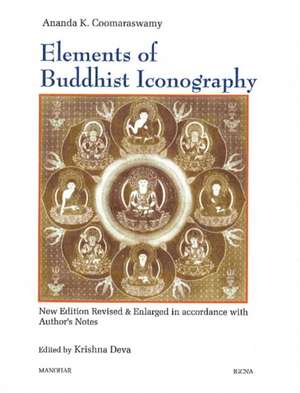Elements of Buddhist Iconography
Autor Ananda Coomaraswamy Editat de Krishna Devaen Limba Engleză Hardback – 31 dec 2008
Preț: 361.61 lei
Preț vechi: 437.50 lei
-17% Nou
69.20€ • 75.14$ • 58.13£
Carte indisponibilă temporar
Specificații
ISBN-10: 8173044325
Pagini: 146
Ilustrații: 44 b/w illus
Dimensiuni: 220 x 285 x 20 mm
Greutate: 0.79 kg
Editura: Manohar Publishers
Colecția Manohar Publishers (IND)
Cuprins
Preface; Introduction; Abbreviations; Foreword; Pat I: Tree of Life, Earth-Lotus and Word-Wheel; Part II: The Place of the Lotus-Throne; Notes; Plates.
Descriere
Sixteenth in the Series of Collected Works of Dr. Ananda Coomaraswamy in the IGNCAs publication programme. Elements of Buddhist Iconography was first published by the Harvard University Press in 1935. this new edition, ably edited and revised by Shri Krishna Deva, has been enriched by incorporating the addition made by Coomaraswamy in his own hand in his personal copy. This volume is a sustained demonstration of Coomaraswamys knowledge of the external features of iconography, his knowledge of the entire metaphysical tradition underlying the iconography, as well as the corresponding traditions in Islam and Christianity. It is a demonstration of the characteristics of a universe of discourse based on detailed textual, iconographic, and comparative studies that include the metaphysics, phraseologies, and iconographics of Hinduism, Buddhism, Christianity and Islam. Buddhist art in India begins about the second century BC, with a well developed set of symbols in its iconography. But it does not seem possible to completely separate Buddhism as religion and art from the main current of Indian religion and art, or to think these symbols suddenly developed as a new creation. Coomaraswamy believes that the source of early iconography of the Buddhist art is in still earlier Vedic and Upanisadic conceptions. In addition, he noticed many surprising similarities between passages in the Vedic literature and in the mediaeval Christian theologians and mystics. The illuminating parallels found in the non-Indian traditions convinced him that mystical theology the world over is the same. The present study deals with the basic symbols of Buddhist art, viz., the Tree of Life, the Earth-Lotus, the Word-Wheel, the Lotus-Throne, and the Fiery Pillar, and shows that these symbols can be traced back beyond their first representation in Buddhist Iconography through the anicomic period of the Brahmanical Vedas, even into the Rig Vedic period itself, and that they represent a universal Indian symbolism and set of theological concepts.
